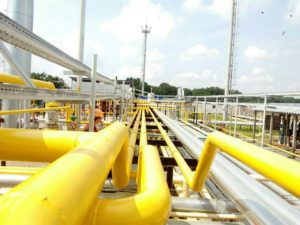
Burisma Group, a gas producer, in January 2019 started building a gas pipeline that would connect Vodianivske and Karaikozivske fields in Kharkiv region and plans to invest UAH 60 million in the project, the company’s press service has reported.
The company expects that the new gas pipeline will allow boosting efficiency of operation and management of flows between the two fields. The length of the new gas pipeline will be 16.6 km.
Burisma Holdings controls Energy & Service Company Esko-Pivnich, LLC KUB-Gas, LLC Pari, the First Ukrainian Gas and Oil Company, SystemOilEngineering, Nadragas, Aldea-Ukraine, Burisma Service, Tehnokomservis, NadraGazVydobuvannia, GasOilInvest, and NGPGeo (Oil and Gas Industrial Geologia).
Mykola Zlochevsky is Burisma’s beneficiary.

PJSC Kyivoblenergo has announced a tender to build the Boryspil solar power plant with a power capacity of 5 MW at 36A, Zaporizhska Street in Boryspil, Kyiv region.
According to the ProZorro e-procurement system, the expected cost of works is UAH 7.305 million. Bids can be submitted before March 1. The auction is to take place on March 4.
At the end of 2017, the executive committee of the Boryspil City Council provided Promin-Energo LLC with town-planning conditions and construction restrictions on a land plot at 36A, Zaporizhska Street in Borispol for the construction of a 5 MW solar power plant. At the end of 2018, Promin-Energo LLC obtained a license to generate electricity for the first stage of the solar power plant at the specified address with a capacity of 996.36 kW from the National Commission for Energy, Housing and Utilities Services Regulation (NCER).
According to the public register of owners of legal entities, as of February 2019, Promin-Energo LLC with a statutory fund of UAH 60 million belonged to four individuals – Eduard Nikitiuk, Yulia Merezhko, Ihor Protsenko and Asatur Baghdasaryan.

ArcelorMittal Kryvyi Rih (Dnipropetrovsk region) in 2018 invested over UAH 600 million in environment protection.
According to the company’s press release, environmental measures allow the company to comply with environmental regulations established by law.
At the same time, the press service said that the company annually allocates funds for the implementation of major investment projects, as well as for the repair of fixed assets related to environmental protection. The repairs help to maintain equipment in working condition and not to increase the burden on the environment.
Thus, in 2018, in the metallurgical production units, repairs were made to gas treatment plants of sintering machines No. 1 and No. 5, twin-steel steel-making unit No. 6, converter No. 3. Also, repair work was done on power equipment (combined heat and power plant three, cooling towers, and water lines).
In the mining department in 2018, the modernization of the crushing and ore-dressing plants was actively carried out: the gas-cleaning equipment was reconstructed, slurry pipelines were repaired and pump units were replaced in the slurry workshop. Last year, the company carried out startup works to launch new aspiration units of sections Nos. 4, 5, 6 of the ore-dressing plant No. 1.
In addition, ArcelorMittal Kryvyi Rih, when implementing large-scale investment projects, introduces the best available technologies, thanks to which it is possible to gradually reduce the burden on the environment. Major investment projects include the reconstruction of coke-oven batteries Nos. 5 and 6 using a set of environmental measures and an automated environmental monitoring system, the modernization of the sinter shop No. 2, the construction of two new machines for continuous casting of billets and new gas treatment plants and the introduction of an automated eco-monitoring system, reconstruction of ore-dressing plants of the mining department, peak boiler house, tailing dumps and other projects.
From 2006 to 2018, the enterprise invested UAH 6.2 billion in the environment, over 120 gas treatment plants were reconstructed and built, thereby achieving national standards.

The Economic Development and Trade Ministry of Ukraine continues working on the creation of a supervisory board of the Export-Credit Agency (ECA) required for the launch of the agency, First Deputy Prime Minister, Minister of Economic Development and Trade Stepan Kubiv has said.
“We have carried out some work and consultations on this issue. I think we will hold another meeting if necessary. We will resolve this issue,” he said at a government meeting in Kyiv.
Prime Minister Volodymyr Groysman reiterated the importance of launching the ECA as soon as possible. At the same time, he added that the delay was due to the fact that the government is launching such a project for the first time.
In addition, Groysman said that the agency will work not so much with its own resources as with tools for attracting resources.
“It is necessary to fill it not with a financial resource, but with tools for access to broad resources, since this is not a question of millions, it is a question of billions, perhaps dozens of billions, to support Ukrainian exports,” he said.
As reported, in February 2018, the Cabinet of Ministers approved the creation of ECA in the form of private joint-stock company and instructed the Economic Development and Trade Ministry to conduct a private placement of its shares.

The International Finance Corporation (IFC), part of the World Bank Group, has signed a loan agreement on providing financing in the amount of EUR 12.5 million to buy 64 large buses, the press service of the Finance Ministry has reported.
According to the press release, the funds are also sent to the reconstruction of the city bus depot, the renovation of repair equipment and the development of the city’s transport infrastructure management. The project will increase the capacity of public transport in the city and reduce hydrocarbon emissions into the atmosphere.
“Since 2014, decentralization is one of the key priorities of the government, and we have already transferred many financial resources to municipalities, and with them responsibility. Therefore, it is extremely important for us that international partners support this approach with financial resources. IFC investments in Mariupol infrastructure, 30 km from the front line is the best proof of our partners’ confidence in Ukraine. We hope that the financing of municipalities will become one of the important activities of the IFC in the future. We would be very grateful if IFC could become the first IFI [international financial institution] that provides such funding in hryvnia, and the Ministry of Finance is ready to support this idea,” the press service of the ministry reported, citing Deputy Minister for European Integration Yuriy Heletei.
As reported, referring to IFC, the loan will amount to 14% of the city’s projected multi-sectoral capital investment program of $90 million in 2019-2010.
IFC, a member of the World Bank Group, is a large international investor focused on the private sector in Ukraine. The total amount of its investment in long-term projects in various economic sectors of Ukraine has reached over $3.2 billion.

Cattle numbers in Ukraine (excluding the temporarily occupied territory of Crimea and part of Donbas) as of February 1, 2019 amounted to 3.392 million animals, which is 3.4% less than on the same date of 2018.
According to the State Statistics Service, the number of cows during this period decreased by 3.6% and amounted to 1.928 million.
The number of pigs fell by 1%, to 5.912 million, sheep and goats by 3%, to 1.265 million.
Poultry numbers in the country compared with February 1, 2018 increased by 3.8%, amounting to 207.614 million birds.